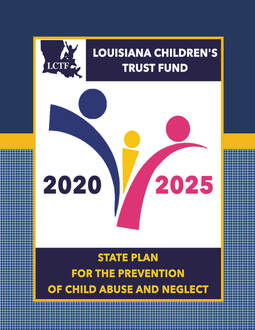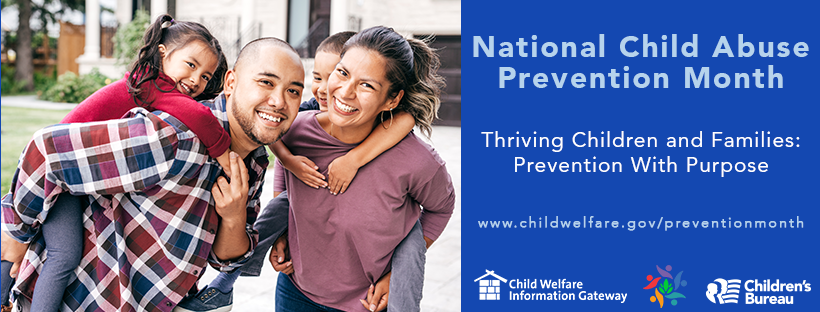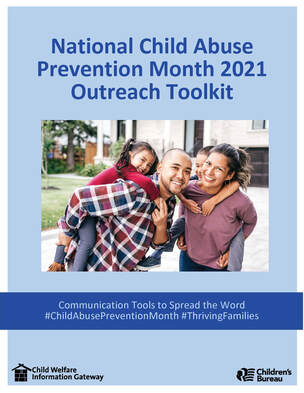|
National Child Abuse Prevention Month recognizes the importance of communities working together to help families thrive and prevent child maltreatment. During the month of April and throughout the year, communities are encouraged to increase awareness about child and family well-being, and work together to implement effective strategies that support families and prevent child abuse and neglect.
New outreach tools are available to help you show your support for National Child Abuse Prevention Month in April. Download the Outreach Toolkit and use the free graphics and sample social media posts to help you make a plan to raise awareness about child abuse prevention. Want to see more resources? Go to the Children's Bureau website!
0 Comments
On behalf of the Board of Directors for the Louisiana Children’s Trust Fund, I am pleased to announce the release of the 2021-2022 Louisiana Children’s Trust Fund Grant Applications.
For more than 37 years the Louisiana Children’s Trust Fund has worked to prevent child abuse and neglect among Louisiana’s children and families through building strong cross-sector partnerships and increased child safety and public awareness. It is our constant goal to support community based efforts to develop, operate, expand, enhance and coordinate initiatives and programs geared toward the prevention of child abuse and neglect. You can find more information about the grant application process here. 2021-2022 grant applications are due by February 22, 2021. We look forward to receiving your applications as you continue to make Louisiana a safe and brighter place for our children! Katina M. Semien, Esq. Executive Director Louisiana Children’s Trust Fund 1051 North 3rd Street #1-136 Baton Rouge, LA. 70802 Telephone: 225.342.2245 Email: [email protected] Purpose: Each year, the Louisiana Children’s Trust Fund (LCTF) releases a statewide funding opportunity announcement (FOA) to community stakeholders for programmatic and conference reimbursement grants. Grant applications received are first evaluated by the Executive Director for compliance with LCTF requirements. Applications that meet the requirements are then randomly assigned to a volunteer grant review team who are responsible for independently reviewing and scoring the individual applications. The three scores are combined and an average composite score determined. The scores are forwarded to the LCTF Board of Directors’ Grant Review Committee which makes recommendations to the LCTF’s Board of Directors. Those recommendations are then forwarded to the Louisiana Children’s Cabinet for final approval.
Who’s Eligible: Grant reviewers are typically individuals with a child and family or education related background that possess a bachelor’s degree or higher and are willing to commit the necessary time to thoroughly review no more than 5 grant applications. The average grant application is no more than 10-12 pages and usually takes between 30-60 minutes to review and score. Expectations of Reviewers:
If you have questions and/or concerns, please do not hesitate to contact us directly at 225.342.2245 or via email at [email protected]. GRANT REVIEWER APPLICATION FORM - Due by January 31, 2021  Click image to access the report. Click image to access the report. The 2020-2025 Louisiana Children's Trust Fund State Plan for Prevention of Child Abuse and Neglect has been released. The new guide will be in place for five years. It will offer updated statistics, general information on child abuse and neglect prevention, regional data and findings, and funding recommendations. The statewide and regional information was determined through a region-by-region series of focus groups, survey data and interviews. This will be the first year that the LCTF grant funding recommendations will be universal for the state and it will be dependent on the use of regional data to create plans that will be specific for the area to be served. Dear Grantees,
In light of the recent devastation suffered due to Hurricane Laura, please find helpful tips below. Please feel free to share with your networks. FEMA ASSISTANCE Regarding FEMA assistance, it is important to share that additional parishes may be added to this declaration, as damage assessments are ongoing. People who sustained losses in Hurricane Laura in the designated parishes of Allen, Beauregard, Calcasieu, Cameron and Jefferson Davis can begin applying for assistance today by registering online at http://www.DisasterAssistance.gov or by calling 1-800-621-FEMA (3362) or 1-800-462-7585 (TTY) for the hearing and speech impaired. The toll-free telephone numbers will operate from 7 a.m. to 10 p.m. (local time) seven days a week until further notice. GENERATOR GUIDANCE Setup Location
In Case of Incident If you think you or someone else has been exposed to carbon monoxide, move the person into fresh air and call your doctor or healthcare provider. If someone has been electrocuted, call 911 for emergency care instructions. Sincerely, K. Semien Katina M. Semien, Esq. - Executive Director Louisiana Children's Trust Fund |


 RSS Feed
RSS Feed